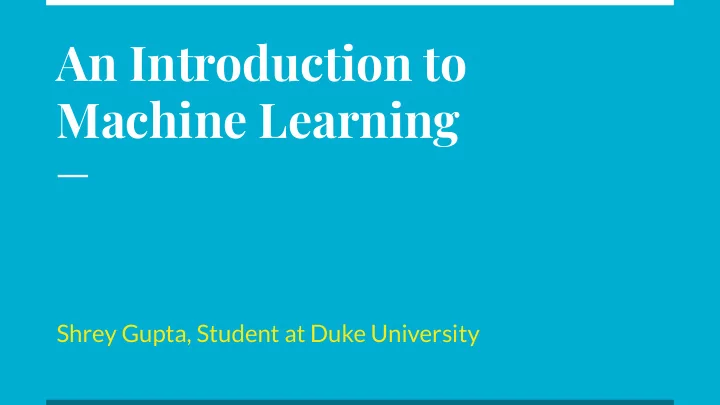

An Introduction to Machine Learning Shrey Gupta, Student at Duke University
Who am I? Senior at Duke University interested in machine learning. Previously research & engineering at Google, quantitative research at hedge fund. Headed to work on self-driving simulation after graduation. Co-founded and now advise Duke’s first undergraduate ML student group.
What is machine learning?
What is machine learning? “Give computers the ability to learn without being explicitly programmed.” -Arthur Samuel
What is (not) machine learning? zip_code = input(‘what is your zip code?’) if zip_code in LIST_OF_NC_ZIPCODES: print ‘user resides in North Carolina!’ if zip_code in LIST_OF_FL_ZIPCODES: print ‘user resides in Florida!’ ...
What is machine learning? input (data) income race output political affiliation state of residence favorite grocery chain ...
What is machine learning? Training data: data used to train algorithm (i.e. create model). example data point income x 1,000 analyze examples race for patterns model political affiliation favorite grocery chain ...
What types of algorithms are there? Grouped into two categories: supervised and unsupervised learning.
Supervised learning: classification Data is labeled, and we want to predict a “class” or “category” as the output. input (data) output feature #1 category #1 feature #2 OR category #2 ... OR ...
Example: classification Given data about temperature, humidity, and wind speed, predict whether it will be sunny, cloudy, or raining. input (data) output temperature sunny humidity OR cloudy wind speed OR raining
Example: classification Predict whether the price of an equity will increase or decrease. input (data) output P/E ratio increase volatility OR decrease analyst sentiment OR stay the same current price
Supervised learning: regression Data is labeled, and we want to predict a continuous output. input (data) output feature #1 value feature #2 ...
Example: regression Predict the percentage increase or decrease in the price of an equity. input (data) output P/E ratio price (dollars) volatility analyst sentiment current price
Example: regression Given data about square footage, age, zip code, and housing demand, predict the selling price of a house. input (data) output age selling price zip code (dollars) square footage housing demand
Unsupervised learning: clustering Data is unlabeled, and we want to cluster the data points into groups.
Example: clustering Given consumption data, partition the consumers into market segments. just retired age 50+ having old a baby just techies high married school college teen teen
Example: clustering Given consumption data, partition the consumers into market segments. what’s everybody else buying?
Example: clustering Given several news articles (and their text), group them based on similarity. election NCAA flu NBA Congress Trump NFL
Example: clustering Given several news articles (and their text), group them based on similarity. here are similar articles you might like!
What is happening today in machine learning?
Computer vision Computer vision is a related field that involves the understanding, processing, and reconstruction of 2- and 3-dimensional images. Common computer vision tasks in machine learning include classification , localization , object detection , and landmark detection .
object classification localization landmark detection detection
Computer vision 1998: Yann LeCun organizes the MNIST database of handwritten digits, and develops a model that can classify handwritten digits.
Computer vision 2012: Google Brain successfully trains a neural network to differentiate images of cats from dogs.
Computer vision 2014: Facebook’s DeepFace successfully uses neural networks to perform facial recognition with over 97% accuracy.
Computer vision 2015: Joseph Redmon invents “You Only Look Once” (YOLO), performing real-time object detection with performance higher than ever before.
Natural language processing Natural language processing is a subset of artificial intelligence concerned with understanding natural language, including text and speech. Examples include sentiment analysis , language translation , reading comprehension , and textual question-answering .
Natural language processing 2006: Google Translate launches, allowing translation between multiple languages for free.
Natural language processing 2011: Siri, a natural language intelligent assistant, launches.
Other impressive achievements 1997: IBM’s Deep Blue beats chess world champion Gary Kaspaov. 2009: The Netflix Prize is won for the best recommender system in predicting user film ratings. 2011: IBM’s Watson is able to defeat human champions in Jeopardy!
Other impressive achievements 2014: The “Eugene Goostman” chatbot fools a third of judges in the Turing test. 2016: DeepMind develops AlphaGo and beats the top-ranked Go player. AlphaGo Zero, which is generalized to chess and other games, is developed the following year.
When is machine learning useful?
Power, complexity, and data We have tons and tons of data, and huge amounts of compute power today. More complex models need lots of data. Otherwise, the model might find patterns that don’t really exist.
Evaluation Need to evaluate your model carefully. Several metrics, such as mean absolute error for regression and accuracy and precision for classification, and methods, such as cross-validation .
Prediction and interpretability Machine learning models are good for prediction, but don’t give underlying causation. Complex models can be difficult to interpret.
Algorithmic bias Machine learning is often used for high stakes decisions, such as determining whether to lend credit, facial recognition for criminals and terrorists, and recidivism. Training data needs to be representative and unbiased .
How do I get started?
How do I get started? Online resources such as Coursera. Attend Duke’s Machine Learning Day (dukeml.org/ml-day) and MLBytes talks (dukeml.org/mlbytes). Start an ML group to gather interest in state-of-the-art tools and technologies being developed. Work on a project that uses ML!
shreygupta.me/durham-tech-slides
Recommend
More recommend